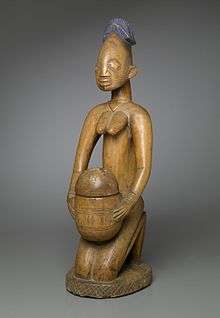Ajere Ifa


Agere ifa (àgéré Ifá) is a container for storing sacred palm nuts for Yoruba divination.
Given its ritual and aesthetic functions, àgéré Ifá provides the Yoruba carver with a unique opportunity to display his artistic talents.
Usually carved from wood and measuring between five and sixteen inches in height, a typical container is in the form of an animal or human figure bearing a small bowl. In some cases, the metaphysical attribute of a given animal motif (such as a snake or mudfish) may be used to further empower the sacred palm nuts inside the bowl. But when the motif assumes a human form, it frequently has a votive significance, especially since some àgéré Ifá are given by clients to a diviner to thank Òrúnmìlà for a blessing or to implore the deity to bestow more favors on the donor.[1] [2]
References
- ↑ Drewal, Henry John; Wardwell, John Pemberton 3rd; edited by Allen (1989). Yoruba : nine centuries of African art and thought. with Rowland Abiodun (2nd print. ed.). New York: Center for African Art in Association with H.N. Abrams. ISBN 0810917947.
- ↑ Lawal, Babatunde (2007). Embodying the sacred in Yoruba art : featuring the Bernard and Patricia Wagner Collection. Atlanta, Ga.: High Museum of Art. ISBN 1932543201.